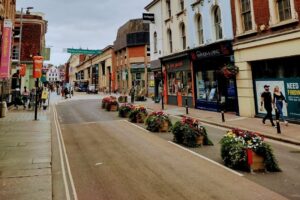Queen Street and Iron Bridge Exeter Scheme – Construction Works
Construction of the permanent changes to widen the footway on the southern side of Queen Street, Exeter, will commence on Monday 17 April 2023 and are expected to last until mid-June.
Works will primarily take place on the section of Queen Street between Northernhay Street and Paul Street. The works includes widening of the southern footway on Queen Street between Northernhay Street and Paul Street.
In addition, there will also be works associated with making the temporary changes to access on Iron Bridge and Paul Street permanent and changes to parking/taxi and loading adjacent to Exeter Central Station.
During the works, businesses will remain open as usual. One lane of traffic, operated under the temporary shuttle signals arrangement that has been in place since 2021, will also remain during the works.

What changes are being made?
The permanent scheme being constructed will encompass:
- Widening of the footway on the southern side of Queen Street;
- Reinstatement of the traffic signals at Paul Street/Queen St junction and signalised crossing outside the Royal Albert Memorial Museum (RAMM);
- Changes to loading including
- Introducing a loading bay on the southern side adjacent to Big Bakes and Brody’s;
- Changing the eastern loading bay outside Exeter Central Station to a taxi bay; and
- Replacing the existing taxi bay with an EV charging point and more disabled parking bays.
- Allowing cycles to enter Queen Street from Paul St;
- Making permanent the one-way system on the Iron Bridge; and
- Advance warning signage of the no entry on Iron Bridge on the approaches to the St David’s Hill/Hele Road mini roundabout junction.
The Scheme Plan shows the planned layout of the road post-construction.
Why are the changes being made?
Temporary changes to provide more space for pedestrians in Queen Street were installed in 2021. Iron Bridge was also made one way, except cycles, to mitigate the impact of displaced traffic on the residential community around St David’s Hill.
The changes are designed to provide improved space and safety for cycling and walking for the 10,000 people that walk or cycle on Queen Street each day.
The changes support the County Council’s encouragement of active travel and aims to reduce the dominance of vehicles in the city centre, both of which are targets of the adopted Exeter Transport Strategy 2020-2030.
Improving facilities for pedestrians on the St David’s station and Queen Street to the City Centre corridor is also identified in the Exeter Transport Strategy’s 5-year Implementation Plan.
What is the impact of the changes?
The impact of the temporary changes has been monitored through regular traffic counts and review of road safety and air quality data.
Vehicular traffic volumes across Iron Bridge and on Queen Street have reduced by a third since the temporary scheme was introduced. Some traffic has displaced onto other routes, such as Bonhay Road, although overall traffic volumes across these roads have reduced.
The number of cyclists has also increased. On Queen St the number of cyclists has increased by 25% (from 680 to 850) and more than doubled on St David’s Hill (from 50 to 130)
The temporary road changes have also had a positive impact on road safety. The Clock Tower roundabout had been a collision cluster site for a number of years, but provisional road safety data shows that there have not been any recorded injury-causing collisions at this junction since the temporary scheme was introduced.
Overview of Collision Data
| Location | Collisions per year before (2015-2019) | Collisions per year after (2021-2022) |
|---|---|---|
| Clock Tower Roundabout | 2.0 | 0.0 |
| Queen St | 2.6 | 2.5 |
What Consultation has taken place
Consultation on the temporary proposals was undertaken in Autumn 2020 and two thirds of public respondents supported changes, with many respondents wanting to see pedestrians and cyclists be given more priority and space on Queen Street in the future. The impact on St David’s Hill was the most raised concern and a hybrid scheme with the smallest impact on that area was progressed.
Public Consultation on a permanent change was undertaken from 15 September to 13 October 2021. Approximately 600 public responses were received with a broadly 50:50 split in favour and against. A summary of the consultation responses is provided with the January 2022 Exeter Highways and Traffic Orders Committee (HaTOC) report.
Following subsequent design changes, further local consultation on a revised scheme was undertaken in October and November 2022. Letters were sent to key stakeholders and approximately 100 properties affected by changes to the layout on Queen Street and Northernhay Street.
The Traffic Regulation Orders for the changes were advertised from the 3 until the 24 November 2022.
Contact details
In the event of any issues during the works, the Transport Planning team can be contacted:
- By email – transportplanning@devon.gov.uk
- By telephone – 0345 155 1004
- By post – Transport Planning, Room 120, County Hall, Topsham Road, Exeter, EX2 4QD
Previous Reports and Consultations
- December 2020 – HaTOC report seeking approval to construct temporary scheme
- July 2021- HaTOC update on Next Steps following temporary scheme
- January 2022 – Autumn 2021 Consultation Summary
- January 2023 – HaTOC report seeking approval to construct permanent scheme
